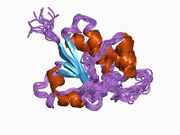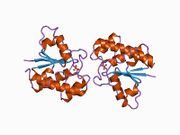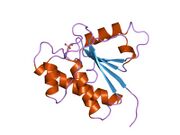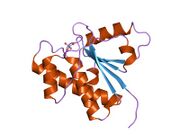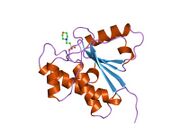Biology:ACP1
 Generic protein structure example |
Low molecular weight phosphotyrosine protein phosphatase is an enzyme that in humans is encoded by the ACP1 gene.
The product of this gene belongs to the phosphotyrosine protein phosphatase family of proteins. It functions as an acid phosphatase and a protein tyrosine phosphatase by hydrolyzing protein tyrosine phosphate to protein tyrosine and orthophosphate. This enzyme also hydrolyzes orthophosphoric monoesters to alcohol and orthophosphate. This gene is genetically polymorphic, and three common alleles segregating at the corresponding locus give rise to six phenotypes. Each allele appears to encode at least two electrophoretically different isozymes, Bf and Bs, which are produced in allele-specific ratios. Three transcript variants encoding distinct isoforms have been identified for this gene.[1]
Clinical significance
Clinically, increased expression of ACP1 is a biomarker for poor prognosis in prostate cancer has been linked to worse clinical behaviour of prostate cancer, possibly outperforming the widely used Gleason grading system with respect to this important parameter.[2] Also in other cancers, e.g. colon cancer, high ACP1 protein levels are linked to aggressive disease.[3] It has been suggested that ACP1 acts as a bona fide oncogene, but for now this notion remains unproven even if ACP1 overexpression drives cells towards a Warburg effect-like glycolytic phenotype.[4] Apart from cancer, ACP1 has also been linked to osteoporosis as the enzyme plays an important role in the interaction of the osteocyte with the bone environment,[5] while its inhibition appears useful for counteracting experimental [venous thromboembolism].[6] Currently, there are no clinically approved inhibitors that allow targeting ACP1 in patients.
Interactions
ACP1 has been shown to interact with EPH receptor A2[7] and EPH receptor B1.[8] The proto-oncogene Src has been suggested to be a direct target for ACP1 tyrosine phosphatase activity, but this has not been formally proven.[9]
References
- ↑ "Entrez Gene: ACP1 acid phosphatase 1, soluble". https://www.ncbi.nlm.nih.gov/sites/entrez?Db=gene&Cmd=ShowDetailView&TermToSearch=52.
- ↑ "Low-Molecular-Weight Protein Tyrosine Phosphatase Predicts Prostate Cancer Outcome by Increasing the Metastatic Potential". European Urology 69 (4): 710–719. April 2016. doi:10.1016/j.eururo.2015.06.040. PMID 26159288.
- ↑ "Platelet-dependent signaling and Low Molecular Weight Protein Tyrosine Phosphatase expression promote aggressive phenotypic changes in gastrointestinal cancer cells". Biochimica et Biophysica Acta (BBA) - Molecular Basis of Disease 1868 (1): 166280. January 2022. doi:10.1016/j.bbadis.2021.166280. PMID 34610471.
- ↑ "Oncophosphosignaling Favors a Glycolytic Phenotype in Human Drug Resistant Leukemia". Journal of Cellular Biochemistry 118 (11): 3846–3854. November 2017. doi:10.1002/jcb.26034. PMID 28387439.
- ↑ "Osteoblast adhesion dynamics: a possible role for ROS and LMW-PTP". Journal of Cellular Biochemistry 115 (6): 1063–1069. June 2014. doi:10.1002/jcb.24691. PMID 24123071.
- ↑ "Targeting Tyrosine Phosphatases by 3-Bromopyruvate Overcomes Hyperactivation of Platelets from Gastrointestinal Cancer Patients". Journal of Clinical Medicine 8 (7): 936. June 2019. doi:10.3390/jcm8070936. PMID 31261776.
- ↑ "Regulation of the EphA2 kinase by the low molecular weight tyrosine phosphatase induces transformation". The Journal of Biological Chemistry 277 (42): 39274–39279. October 2002. doi:10.1074/jbc.M207127200. PMID 12167657.
- ↑ "Eph receptors discriminate specific ligand oligomers to determine alternative signaling complexes, attachment, and assembly responses". Genes & Development 12 (5): 667–678. March 1998. doi:10.1101/gad.12.5.667. PMID 9499402.
- ↑ "Modulation of Src activity by low molecular weight protein tyrosine phosphatase during osteoblast differentiation". Cellular Physiology and Biochemistry 22 (5–6): 497–506. 2008. doi:10.1159/000185506. PMID 19088431.
External links
- Human ACP1 genome location and ACP1 gene details page in the UCSC Genome Browser.
- Overview of all the structural information available in the PDB for UniProt: P24666 (Human Low molecular weight phosphotyrosine protein phosphatase) at the PDBe-KB.
- Overview of all the structural information available in the PDB for UniProt: Q9D358 (Mouse Low molecular weight phosphotyrosine protein phosphatase) at the PDBe-KB.
Further reading
- "Regional assignment of red cell acid phosphatase locus to band 2p25". Human Genetics 48 (1): 17–21. April 1979. doi:10.1007/BF00273269. PMID 457131.
- "Phenotype dependence in the inhibition of red cell acid phosphatase (ACP) by folates". American Journal of Human Genetics 30 (5): 553–560. September 1978. PMID 736044.
- "Identification of the adipocyte acid phosphatase as a PAO-sensitive tyrosyl phosphatase". Protein Science 1 (6): 710–721. June 1992. doi:10.1002/pro.5560010603. PMID 1304913.
- "Sequencing, cloning, and expression of human red cell-type acid phosphatase, a cytoplasmic phosphotyrosyl protein phosphatase". The Journal of Biological Chemistry 267 (15): 10856–10865. May 1992. doi:10.1016/S0021-9258(19)50097-7. PMID 1587862.
- "Human red cell acid phosphatase (ACP1): the primary structure of the two pairs of isozymes encoded by the ACP1*A and ACP1*C alleles". Biochimica et Biophysica Acta (BBA) - Protein Structure and Molecular Enzymology 1121 (3): 261–268. June 1992. doi:10.1016/0167-4838(92)90155-7. PMID 1627603.
- "Human red cell acid phosphatase (ACP1). The amino acid sequence of the two isozymes Bf and Bs encoded by the ACP1*B allele". The Journal of Biological Chemistry 266 (31): 20619–20625. November 1991. doi:10.1016/S0021-9258(18)54754-2. PMID 1939112.
- "Duplication of 2p25: confirmation of the assignment of soluble acid phosphatase (ACP1) locus to 2p25". Human Genetics 71 (3): 259–260. 1986. doi:10.1007/BF00284586. PMID 4065897.
- "Expression of human red cell acid phosphatase activity in placenta and other tissues". Jinrui Idengaku Zasshi. The Japanese Journal of Human Genetics 18 (1): 10–23. June 1973. PMID 4356849.
- "A TaqI site identifies the *A allele at the ACP1 locus". Human Molecular Genetics 2 (7): 1079. July 1993. doi:10.1093/hmg/2.7.1079-a. PMID 8364553.
- "Gene structure, sequence, and chromosomal localization of the human red cell-type low-molecular-weight acid phosphotyrosyl phosphatase gene, ACP1". Genomics 30 (2): 133–140. November 1995. doi:10.1006/geno.1995.9893. PMID 8586411.
- "Regulation of the low molecular weight phosphotyrosine phosphatase by phosphorylation at tyrosines 131 and 132". The Journal of Biological Chemistry 272 (9): 5371–5374. February 1997. doi:10.1074/jbc.272.9.5371. PMID 9038134.
- "Eph receptors discriminate specific ligand oligomers to determine alternative signaling complexes, attachment, and assembly responses". Genes & Development 12 (5): 667–678. March 1998. doi:10.1101/gad.12.5.667. PMID 9499402.
- "Cloning, expression and characterisation of a new human low Mr phosphotyrosine protein phosphatase originating by alternative splicing". FEBS Letters 431 (1): 111–115. July 1998. doi:10.1016/S0014-5793(98)00732-7. PMID 9684876.
- "Crystal structure of a human low molecular weight phosphotyrosyl phosphatase. Implications for substrate specificity". The Journal of Biological Chemistry 273 (34): 21714–21720. August 1998. doi:10.1074/jbc.273.34.21714. PMID 9705307.
- "A novel isoform of the low molecular weight phosphotyrosine phosphatase, LMPTP-C, arising from alternative mRNA splicing". European Journal of Biochemistry 262 (2): 277–282. June 1999. doi:10.1046/j.1432-1327.1999.00353.x. PMID 10336608.
- "HCPTPA, a protein tyrosine phosphatase that regulates vascular endothelial growth factor receptor-mediated signal transduction and biological activity". The Journal of Biological Chemistry 274 (53): 38183–38188. December 1999. doi:10.1074/jbc.274.53.38183. PMID 10608891.
- "Tyrosine phosphorylation regulates alpha II spectrin cleavage by calpain". Molecular and Cellular Biology 22 (10): 3527–3536. May 2002. doi:10.1128/MCB.22.10.3527-3536.2002. PMID 11971983.
- "Activation of ZAP-70 through specific dephosphorylation at the inhibitory Tyr-292 by the low molecular weight phosphotyrosine phosphatase (LMPTP)". The Journal of Biological Chemistry 277 (27): 24220–24224. July 2002. doi:10.1074/jbc.M202885200. PMID 11976341.
- "ACP1 is associated with allergy". Allergy 57 (7): 651–652. July 2002. doi:10.1034/j.1398-9995.2002.23722.x. PMID 12100313.
- "Regulation of the EphA2 kinase by the low molecular weight tyrosine phosphatase induces transformation". The Journal of Biological Chemistry 277 (42): 39274–39279. October 2002. doi:10.1074/jbc.M207127200. PMID 12167657.
 |
